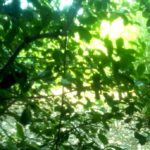 They’re old enough to be out and about, trying to function in the world for the first time.
They’re old enough to be out and about, trying to function in the world for the first time.
A young jay, with gray fuzz sticking out from wings that were still pale blue, its head a tufted gray ball, struggled to balance on a low branch in the shrubbery. Its short brilliant-blue tail feathers bobbed up and down in quick waves. After fluttering wildly, it fell onto the branch below and teetered, barely able to wrap its tiny filament-feet around the wood. The apparent parent – full-bodied, sleek, powerful, dark blue, and adept – lofted to higher branches and emitted sharp signals: “Up here! Move it, knucklehead!” Or maybe it was, “Whoa, sweetie, stay down, there’s a hawk overhead!” I wondered if the wobbly little bird was as clueless as I was about the signals.
An almost desperate compassion filled me and traveled to the youngster. Projecting all my interpretations onto it, I felt necessity, frustration, fear of failure, with no choice but to keep trying. Does it know about the cats that will be so quick to pounce if it falls at the wrong time and can’t muster the skill to re-launch itself? I remembered the experiment where newly hatched chicks panicked when a paper silhouette of a hawk, flying forward, was passed over them – but not when the image was moved backwards (and looked like a goose). That was my own beginning of wondering about how much we start out with, insight-wise – the nature-nurture debate now exploding with investigations into DNA and epigenetics, discussions about past lives and the collective unconscious.
How much of what we instinctively do is truly new? Creativity is by definition about entering oneself into an unknown zone. Every new thing is a baby bird, in the nest of our expert lives, and “it” (the part of us that’s learning) needs care and encouragement to fledge.
For a bird, flight is forced newness. For a human, forced newness might come from the loss of old supports, from necessary encounters with strangers, from changes in outer circumstances, or from inner changes and altered perceptions – maybe even brand-new inspiration. Disappearance of a familiar environment or trajectory can paralyze, unless there’s an openness to the new, a willingness to engage actively with uncertainty and dance with it. I believe that’s why “Hope is the thing with feathers.”
Seeing the two birds was a momentary grace: so far, they haven’t reappeared in that spot while I was looking. Empty branches reminded me how fleeting every moment is – even time flies. When I looked at the vacant shrub, I realized I couldn’t know whether the fuzzy fledgling was on the way to sleek mastery, enjoying the wild bright sky – or had become something’s dinner. I got a deeper felt-sense understanding about why we frequently stay with what we know, avoiding the exposure of a beginner’s ineptitude. Every deliberate movement is, by Nature, a step into the unknown and yet an expression of hopefulness – with or without access to a known, unchanging, alive and self-aware stillness at the core.
A journey of a thousand flights – or just one – begins with a single flutter.